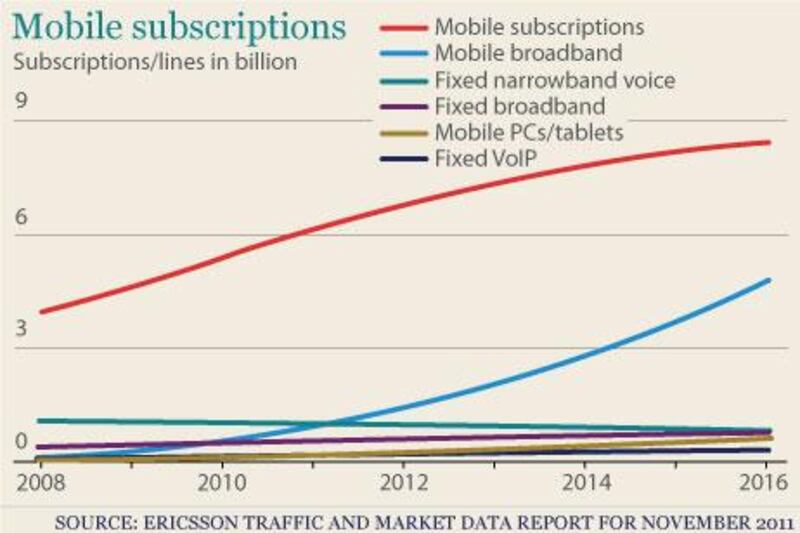Mobile subscription rates in the Middle East have grown to 96 per cent of the region's population, trumping the global average of 82 per cent, says the phone giant Ericsson.
Ringing the changes:Discover what the UAE telecoms have planned
Etisalat Learn more
Du Learn more
The region is ahead of emerging markets such as China at 69 per cent, India at 70 per cent and Africa at 55 per cent, said the company's traffic and market data report for this month.
Data services are driving demand among mobile users.
According to the research company Informa Telecoms & Media, people in Gulf nations such as the UAE own close to two mobile phones each, resulting in an estimated mobile penetration rate of 155 per cent, almost double that of countries such as Lebanon, which is still in the process of implementing its 3G network.
"You can say a lot of the region is trailing the Gulf," said Jeremy Foster, the head of marketing, government and industry relations for Ericsson Middle East and Africa.
"We do have this kind of band in the middle of the Gulf region where we have well over 100 per cent," he said.
The Ericsson report said the Middle East was just behind North America, where 97 per cent of the population owns mobile phones.
Meanwhile, western Europe and central and eastern Europe top the list with 126 per cent and 123 per cent subscription rates respectively.
However, growth in mobile penetration in the Middle East has outpaced the West. There were 7.7 million new connections in the region in the third quarter of this year compared with 3.1 million in western Europe and 3.6 million in North America.
The Middle East is in line with the global trend of growing data demands, according to Ericsson.
"We are tracking an extraordinary surge in broadband data consumption here in the Middle East and around the world and we are expecting a 10-fold increase in mobile data traffic by 2016," said Anders Lindblad, the president of the Middle East and North Africa region for Ericsson.
"Importantly, we are also seeing that telecommunications operators in the region are keeping pace with this change in demand, as demonstrated by the recent 4G or LTE launches," said Mr Lindblad.
Matthew Reed, an analyst at Informa, also expected mobile data traffic to grow substantially in the region.
He attributed this to the arrival of data networks and services, relatively affluent markets and stronger competition in telecoms markets.
However, he said there were challenges for the Middle East in terms of keeping up with demand.
"One of the constraints is on international connectivity, although there are some new undersea cables under way," he said.
"Eventually if it is scarce, it becomes expensive and that could constrain services."
The Ericsson report also said worldwide mobile subscriptions now totalled about 5.8 billion, with the number of subscribers estimated to be about 3.9 billion, since many have more than one phone.
Ericsson also said about 10 per cent of worldwide subscribers used smartphones, and global mobile broadband subscriptions would reach almost 5 billion in 2016, from the expected 900 million by the end of this year.
twitter: Follow and share our breaking business news. Follow us





